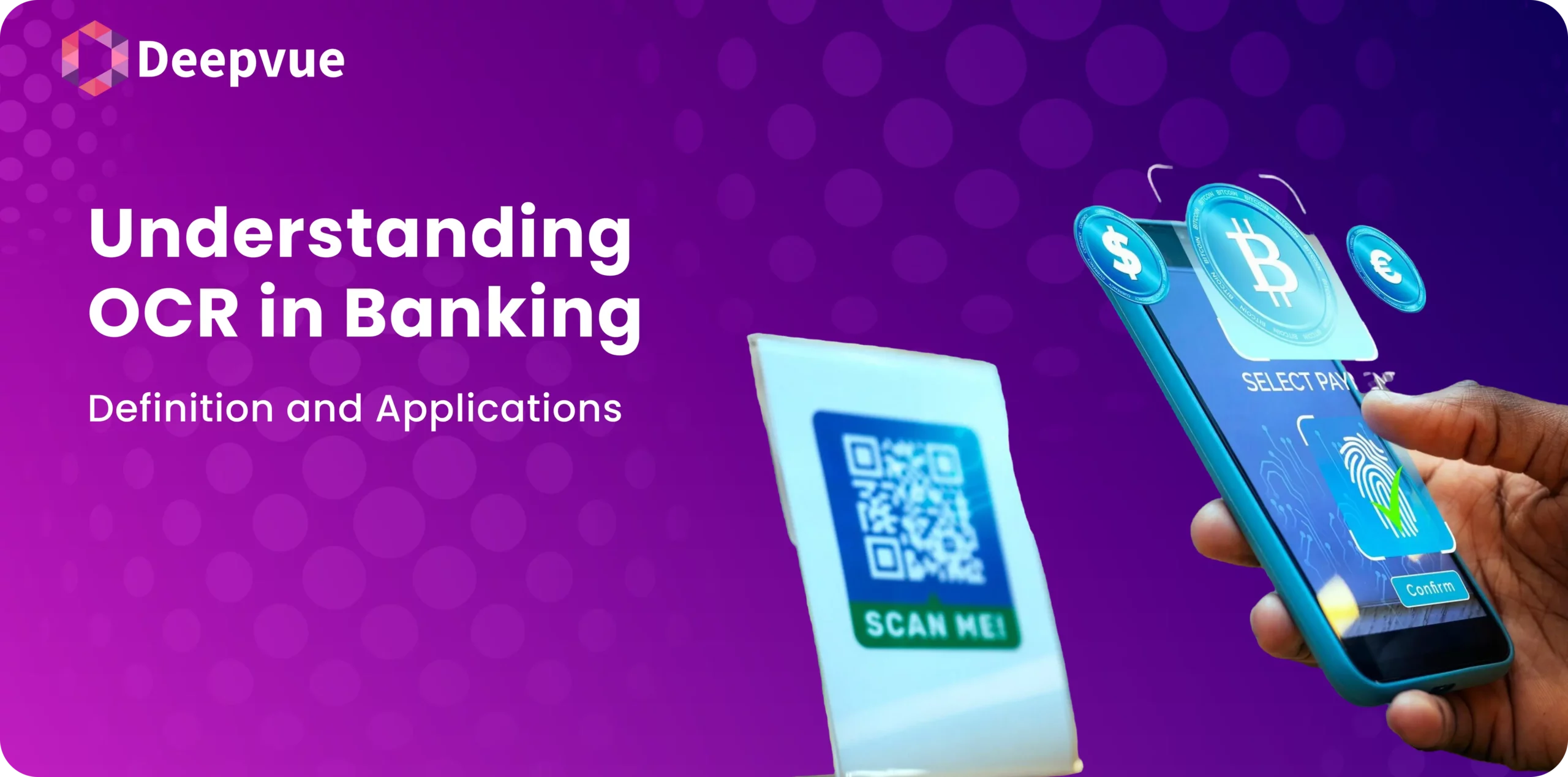Optical Character Recognition (OCR) technology is revolutionizing the banking industry by automating manual processes. Banks have transformed their ways of handling information by using OCR to convert different types of documents—such as scanned paper documents, PDFs, or images—into editable and searchable data.
In this blog, we will tell you about what OCR is, how it works, and its applications and benefits in the banking sector.
What is Optical Character Recognition, OCR?
Optical Character Recognition (OCR) is a technology that converts documents such as scanned paper documents, PDFs or images into editable and searchable data.
In simple words, OCR takes out text from such papers, changing them into digital files which can be read by computer systems.
How Does Optical Character Recognition – OCR Work?
Understanding the basics of how OCR works can help you understand its role in banking:
- Image Capture: The first step is capturing the document image using a scanner or a camera.
- Pre-Processing: At this stage, the quality of the captured image is enhanced. This includes eliminating any noise, aligning any tilt on the image and converting it to black and white to increase accuracy.
- Text Recognition: This identifies characters from an image; there are two main approaches:
- Pattern Recognition: where software compares text in document with pre-stored character patterns
- Feature Extraction: where software scrutinizes characters’ structure like lines or curves for example to identify text
- Post-Processing: The recognized text is processed and corrected using context and dictionaries to ensure accuracy.
What is OCR in Banking?
OCR in banking refers to the use of Optical Character Recognition technology to streamline the processing of financial documents. It automatically extracts text from scanned images or PDFs of bank statements, converting them into editable and searchable formats. This digitized data is then used for accurate financial analysis, transaction reconciliation, compliance checks, and reporting. By reducing manual data entry and minimizing errors, OCR in banking significantly improves operational efficiency, enhances data accuracy, and supports faster decision-making across various financial workflows.
Why OCR in Banking Is Critical for Digital Transformation
Banks need to process large amounts of paperwork every day in the form of opening account forms, loan applications, cheques, etc. Processing them manually is not only time-consuming but is also error prone.
This procedure is automated by OCR and hence makes it quicker, more accurate, and cost-effective. This increases productivity and improves customer experience.
Types of OCR Technology Used for Bank Statement Processing
Bank statement processing involves extracting and analyzing financial data to streamline tasks such as loan approvals, credit assessments, and expense tracking. OCR (Optical Character Recognition) technology plays a crucial role in digitizing bank statements by converting printed or handwritten text into machine-readable formats. Below are the key types of OCR technologies used for bank statement processing:
- Traditional OCR: Basic OCR technology that reads and extracts characters from printed text.
- Zonal OCR: Extracts information from predefined areas or zones on a document.
- Intelligent OCR (I-OCR): Combines OCR with machine learning and natural language processing to recognize and extract data from complex and unstructured documents.
- Template-Based OCR: Uses pre-defined templates to extract data from documents with a fixed structure.
- Cognitive OCR: Advanced OCR that mimics human-like understanding by leveraging AI, machine learning, and computer vision technologies.
- Cloud-Based OCR: OCR technology deployed through cloud services for real-time processing and scalability.
Applications of OCR in Banking
Some of the major applications of OCR bank technology are-
1. Automated Data Entry
OCR automates data entry by extracting text from documents like cheques, invoices, forms, etc. This saves time and reduces the possibility of human error.
2. Document Management
Banks process a lot of paper every day. Consequently, digitizing such papers with OCR makes them easily searchable and accessible, hence improving efficiency within the document management systems.
3. Customer Onboarding
There are several bank documents like identity & address proof, etc. These documents need to be verified in the process of customer onboarding. In such cases, OCR simplifies this by quickly getting and confirming required information.
4. Fraud Detection
The OCR can even help in detecting fraudsters since it authenticates documents. This kind of software will match the scanned documents with information that has been obtained from elsewhere; thus, irregularities and fraudulent activities will be identified.
5. Cheque Processing
OCR technology speeds the scanning and processing of cheques, extracting information such as account number, cheque number, and amount which are required in clearing the cheque.
6. Compliance and KYC
Banks are required to abide by regulations such as Know Your Customer (KYC) and Anti-Money Laundering (AML). This is where OCR comes in— to aid in the extraction and verification of such information when it comes to the customers.
Benefits of OCR in Banking
Adoption of OCR technology has brought several commendable benefits in the banking sector. They include:
1. Increased Efficiency
OCR efficiently reduces the time and effort by automating data entry & document processing. This allows banks to focus more on value-added activities.
2. Enhanced Accuracy
Manual data entry has higher chances of error. OCR improves accuracy through minimum human intervention and correct data capturing.
3. Cost Savings
Physical storage of documents; and cost of manual data entries related to these, is reduced. Hence, banks save huge costs.
4. Improved Customer Experience
Due to the better and faster processing and accurate data capture, the overall customer experience is enhanced. Customers feel more satisfied as they enjoy faster experiences with seamless onboarding.
5. Better Data Management
Records that are digitized can be easily managed, searched for, and retrieved at the time of need. OCR helps in organizing large volumes of data efficiently.
Deepvue’s OCR Solutions: Secure, Scalable & Accurate
At Deepvue, we offer the banking sectors with reliable and robust OCR solutions. Our API infrastructure properly integrates with your existing systems smoothly, without any hiccups for a smooth transition to automated data processing. Here’s how our solutions can help your bank-
1. Document Verification
Our OCR technology checks identity cards, passports, and bank statements to verify its authenticity and accuracy. This is extremely significant for compliance with KYC/AML rules & laws.
2. Cheque OCR
Cheque OCR extracts details from cheques with a high level of accuracy. This helps in increasing processing speed when clearing cheques, with minimum errors.
3. ID Card OCR
We provide OCR solutions for a wide range of document identification that ensure fast and accurate data extraction, which is specifically ideal for customer onboarding and verification.
4. Customizable Solutions
Our OCR solutions are custom-made to suit every need that fintechs and banks may have. Be it document verification, cheque processing, or customer onboarding; we can always tailor our services to fit your requirements.
Conclusion
Optical Character Recognition (OCR) is revolutionizing the banking sector by automating data entry, improving accuracy, and enhancing efficiency. OCR technology is one of the most important game-changers for banks looking toward improving operational efficiency and serving customers better in regard to its wide reach of applications..
At Deepvue, we are deeply committed to bringing advanced OCR solutions, which will help banks not only catch up with but move ahead of the competitive landscape. Feel free to visit our website or write to us if you need further details or to schedule a demo. Let Deepvue be your partner in digital transformation.
FAQs
What is the primary purpose of OCR in banking?
OCR’s primary purpose is to extract data and process that data from various documents; thereby handling transactions efficiently, onboarding customers, and complying with requirements.
How does OCR improve customer onboarding?
OCR improves customer onboarding by quickly extracting and verifying information from identity documents that reduce the time and effort required for manual data entry. This makes onboarding faster and error-free.
Can OCR handle handwritten documents?
Yes, it can read handwritten documents but this depends on how well they are written and legible they are perceived to be. Technologies like ICR are targeted more on enhancing the recognition of such handwritten texts.
What are the compliance benefits of using OCR in banking?
Compliance— OCR helps digitize and systematically arrange the required documents for banks, making them very easy to retrieve in case of audits or regulatory checks. This helps banks meet their KYC and AML requirements much more efficiently.
How secure is the data processed by OCR technology?
Most of the OCR technology uses encryption or other security measures to ensure that sensitive information is safe. Use of OCR reduces the risk of human error and data breaches when data is manually handled.








